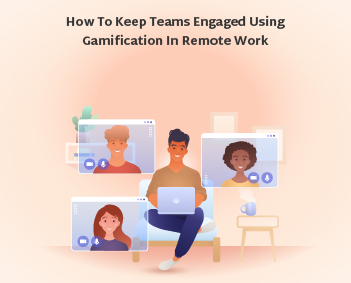Remote work has become increasingly prevalent, with many organizations shifting to fully or partially distributed teams. Gamification in remote work provides flexibility as it possesses unique engagement challenges. Maintaining team cohesion, morale, and productivity can be difficult without in-person interaction.

Gamification presents a promising solution to reenergize engagement among remote teams. If you gamify your workforce, you can ignite desires for competition, achievement, status, and reward in your remote team. If implemented thoughtfully, gamification in a remote workforce can reinvigorate individuals and foster a thriving virtual work culture.
This blog will explore how organizations can leverage gamification to motivate and engage remote teams in new remote-first work realities.
Understanding Gamification in Remote Work
What is Gamification?
Gamification refers to the use of game mechanics and elements in non-game contexts. It involves applying things like points, levels, challenges, leaderboards, and loyalty rewards to drive participation, engagement, and motivation.
While often associated with consumer apps and marketing, gamification is increasingly helpful in remote work scenarios. It enables you to encourage desired behaviors and infuse traditionally mundane tasks with a spirit of fun and friendly competition.
Well-executed gamification connects work activities to intrinsic motivations like mastery, progress, and purpose. It taps into our natural desires for achievement and status within a community.
Why Gamify Your Workforce for Remote Work?
Implementing gamification strategies in remote teams can yield several benefits:
Increased motivation and engagement:
Gamification taps into our inherent desire for challenge, competition, and reward. This leads to greater participation, focus, and sense of accomplishment.
Improved communication and collaboration:
Shared goals and incentives facilitated by gamification mechanics foster closer teamwork and peer motivation. Overall, communication becomes seamless, too.
Enhanced Learning And Development:

Gamification can make training more enjoyable and effective through rewards, feedback loops, and friendly competition. Completion rates for eLearning courses can see over 50% boosts with gamified elements. Talking about eLearning, there is no better way than downloading LearnDash to your website.
Elevated Employee Morale And Well-Being:
Recognition, rewards, and a sense of progress and achievement can greatly lift team spirit and morale long-term. One study found enterprise gamification increased happiness levels by 63%.
Data And Insights:
Gamification provides rich behavioral data that offers insights into team dynamics and performance patterns when analyzed over time. This allows for optimization.
With distributed remote teams, thoughtfully designed gamification strategies can increase participation and productivity across virtual environments.
Myths and Misconceptions About Gamification for Remote Teams
Some common myths about implementing gamification in remote work include the following:
- It’s just for millennials – Well-designed games resonate across demographics. Customize experiences based on user data.
- It’s unnecessary when intrinsic motivation is high – Even highly engaged teams can benefit from gamification programs.
- Short-term gains don’t last – Sustained engagement requires continuous iteration and new mechanics.
- Meaningful work can’t be gamified – Connect mechanics to purpose and set challenges that develop high-value skills.
Implementing Gamification Effectively
Rolling out an impactful gamification program requires thoughtful strategy and consideration. Here is a step-by-step guide:
Identify your goals
Define the specific business objectives and outcomes you want to achieve, like increased training course completion rates or higher customer satisfaction scores.
Define target behaviors
Determine specific team behaviors and actions you aim to encourage through gamification in remote work. This could include attending meetings promptly, completing tasks by deadline, or answering customer calls swiftly.

Choose engaging mechanics
Select game elements to implement gamification in remote work that align with your goals and target behaviors, like:
- Points earned for taking training courses or positive customer reviews
- Badges as recognition for major contributions or milestones
- Leaderboards displaying top individual and team performance
- Leveling up through different tiers by accumulating points
- Challenges and quests to complete as teams
- Virtual rewards like gift cards, charity donations, or trophies
Integrate Gamification Seamlessly
The essence of gamification in remote work is fun. Thus, game elements should integrate seamlessly into existing remote work platforms. Always avoid disjointed experiences that repel teams from acting in a synchronized way, especially during employee training.

Monitor Your Workforce’s Performance
Continuously track program analytics to gauge the impact of gamifying your workforce. Gather feedback through surveys. Also, adjust mechanics accordingly to optimize engagement and relevance.
Key Game Mechanics and Examples for Remote Workforce
Here are some proven game mechanics, along with examples of gamification in remote work:
- Points – Award points for desired activities like completing training courses. Offer bonuses for high scores.
- Badges – Give badges when milestones are met, like mastering skills or high customer satisfaction marks.
- Leaderboards – Display rankings highlighting top teams or individuals for metrics like sales numbers, productivity stats, or responsiveness.
- Levels – Advance users through different tiers, ranks, or worlds as they accumulate more points, complete missions, or master abilities.
- Challenges – Issue company-wide challenges focused on goals like 30 minutes of daily wellness activities or sustainability targets.
- Rewards – Offer individual rewards like gift cards for top performers or team rewards like a catered virtual dinner for the highest customer satisfaction rating.
You can implement all of the above and additional gamification stuff for your remote teams using myCred. It’s a one-stop shop to gamify your workforce.

What are the Techniques to Gamify your Workforce
Here are some of the effective tactics to gamify your workforce working remotely:
- Unexpected rewards – Surprise high scorers with rewards or recognize employees publicly for exceptional achievements. The element of surprise and social recognition enhances the impact of gamification in remote work.
- Appointment dynamics – Use countdown timers to incentivize immediate participation to access limited events or challenges.
- Community collaboration – Have leaders and top performers mentor others during challenges and highlight team participation over individual success.
How to Overcome Challenges of Gamification in Remote Work
Working remotely always brings some intricate challenges. Here are some of the challenges you may face to gamify your workforce:
Challenges and Considerations
- Finding the right balance – Avoid overly competitive dynamics and ensure gamification aligns with company values and culture.
- Over-simplification of work – Don’t reduce complex responsibilities solely to point accumulation. Focus on intrinsic motivations and purpose.
- Accessibility – make space for communication preferences, learning styles, backgrounds, and technical literacy.
Best Practices for Successful Gamification
Following are some of the preferred best practices to gamify your workforce working remotely:
- Focus on intrinsic motivation – Connect gamification to work tasks’ deeper purpose and meaning.
- Customize the experience – Personalize gamification in remote work to resonate across user demographics and preferences.
- Seek continuous feedback – Gather insights through surveys and informal outreach. Iterate based on input.
- Promote consistently – Communicate program updates, reminders, and new mechanics via multiple channels to sustain interest.
- Incentivize participation – Encourage enrollment by awarding sign-up points and highlighting peer involvement.
- Leverage team dynamics – Build team affiliation by allowing groups to unlock rewards and utilize collaboration mechanics.
How to Launch an Initiative for Gamification in Remote Work
Rolling out a gamification program requires cross-functional collaboration:
Work With Leaders and Managers
- Provide guidelines on how to integrate gamification without overburdening teams.
- Help managers connect game elements to real performance goals.
- Have them encourage participation and share success stories.
Involve Team Members
- Survey employees on incentives and rewards most appealing to them before the program launch.
- Gather employee input on the types of challenges and mechanics that would resonate with your remote team.
Partner With HR
- Ensure alignment with company culture, values, and norms.
- Collaborate on relevant rewards like career development opportunities.
Leverage existing infrastructure
- Integrate gamification software into employees’ communication and collaboration platforms to avoid disruption.
- Tap into workflow tracking and embedded analytics tools to track relevant metrics.
Measuring Success & Optimizing in Gamification for Remote Work
Once you’ve launched your gamification initiative, monitoring performance and continually optimizing the experience is critical. Here is a list of KPIs to track progress after implementing gamification in remote work:
Key Performance Indicators
- Engagement – Program enrollment, active usage, challenge participation
- Behaviors – Completion of target behaviors like training programs finished
- Productivity – Improvement in key performance indicators being gamified, like sales or response times
- Satisfaction – Employee feedback scores on engagement and enjoyment of the program
How to Optimize Best Practices for Implementing Gamification

Following are some of the ways to enhance gamification in remote work impact:
- Regularly change up challenges and mechanics to combat stagnation
- Analyze engagement data to identify poorly resonating elements
- Conduct surveys and informal check-ins to gather user feedback
- Personalize experiences based on participation patterns and preferences
- Expand reward offerings and possibilities to maintain interest
- Highlight success stories and recognize top participants
Final Words
The future of work will require creative solutions to connect our distributed teams, and gamification provides a powerful way to foster the collaboration, camaraderie, and culture organizations need to succeed. Thus, implementing gamification in remote work requires a thoughtful strategy paired with robust data analysis and iteration. With remote work becoming the norm, it is important to gamify your workforce by using the above tips to inspire greater participation despite physical distance.
